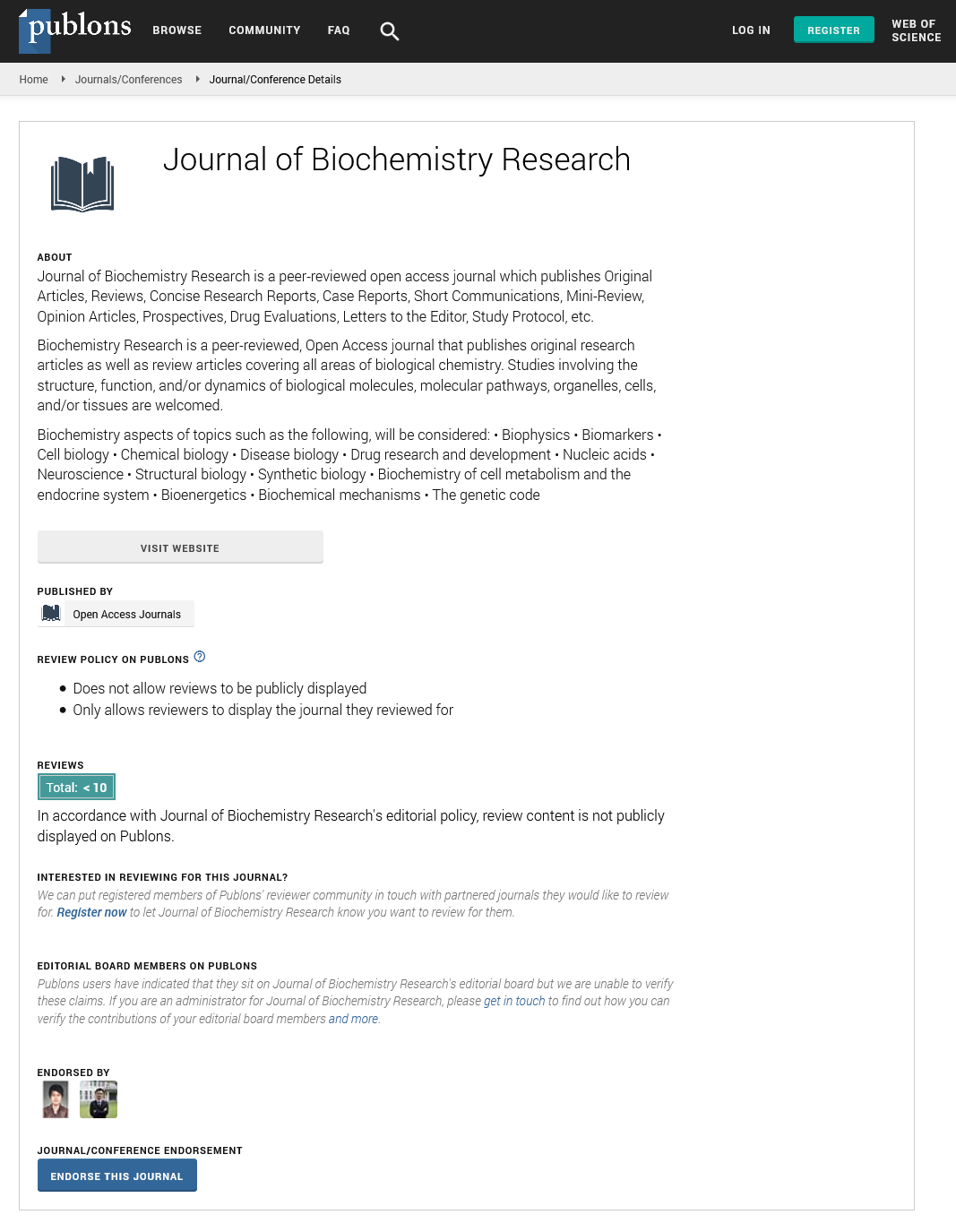Editorial - Journal of Biochemistry Research (2023) Volume 6, Issue 3
Decoding the Intricacies of Molecular Pathways: Unlocking the Secrets of Life
Dr. Jon Li*
College of Computer Science and Engineering, Department of Computer Science, University of China
College of Computer Science and Engineering, Department of Computer Science, University of China
E-mail: jonl@gmail.com
Received: 02-06-2023, Manuscript No. oabr-23-101500; Editor assigned: 05-06-2023, Pre QC No. oabr-23- 101500; Reviewed: 19-06-2023, QC No. oabr-23-101500; Revised: 22-06- 2023, Manuscript No. oabr-23-101500 (R); Published: 29-06-2023; DOI: 10.37532/oabr.2023.6(3).47-50
Abstract
Molecular pathways play a crucial role in cellular processes and the regulation of various biological functions. These pathways consist of a series of interconnected molecular interactions that govern signal transduction, gene expression, and cellular responses. Understanding the intricacies of molecular pathways is essential for unraveling disease mechanisms, identifying potential therapeutic targets, and developing novel treatments. This abstract provides an overview of molecular pathways, their components, and their significance in cellular biology. It highlights the importance of studying molecular pathways to gain insights into complex biological systems and facilitate advancements in the fields of medicine and biotechnology.
Keywords
Molecular pathways • Signal transduction • Gene expression • Cellular responses • Disease mechanisms • Therapeutic targets • Biological systems
Introduction
Within the complex world of biology, understanding the fundamental processes that govern life is crucial. Molecular pathways play a pivotal role in regulating various cellular activities and orchestrating the intricate dance of biochemical reactions. These pathways serve as information highways, enabling communication, coordination, and control within cells and tissues[1]. Exploring molecular pathways provides invaluable insights into the mechanisms underlying both health and disease, offering a foundation for medical advancements and therapeutic interventions[2]. In this article, we delve into the fascinating world of molecular pathways, uncovering their significance, components, and the remarkable discoveries they have unlocked[3]. Molecular pathways are intricate networks of molecular interactions and signaling cascades that play a crucial role in various biological processes. These pathways enable cells to communicate, respond to stimuli, and carry out essential functions necessary for the proper functioning of living organisms[4]. By understanding and deciphering molecular pathways, scientists can gain insights into the complex mechanisms underlying physiological and pathological conditions, paving the way for advancements in medicine and biotechnology[5]. At the molecular level, cells employ an array of signaling molecules, including proteins, lipids, and nucleic acids, to transmit information and orchestrate a multitude of cellular responses[6]. These signaling molecules engage in intricate interactions, forming elaborate pathways that regulate processes such as cell growth, development, metabolism, immune response, and apoptosis (programmed cell death). Molecular pathways also contribute to the coordination of complex physiological systems within organisms, including neuronal signaling, hormonal regulation, and tissue repair[7]. The exploration of molecular pathways involves studying the interactions between molecules and the cascade of events that occur within cells upon stimulation. These pathways often involve a series of molecular switches, where the activation or inhibition of one molecule leads to the activation or repression of subsequent molecules in the pathway[8]. Understanding the intricate relationships and interdependencies within these pathways allows researchers to identify key regulatory points and potential therapeutic targets for various diseases. Advancements in molecular biology techniques, such as genomics, transcriptomics, proteomics, and metabolomics, have revolutionized our ability to investigate molecular pathways comprehensively[9]. These high-throughput technologies enable the simultaneous examination of thousands of molecules and their interactions, providing a holistic view of complex cellular processes. Additionally, computational methods and bioinformatics tools have become indispensable in analyzing the massive amounts of data generated by these technologies, facilitating the identification and characterization of molecular pathways. The study of molecular pathways has profound implications in multiple fields of research, including molecular medicine, drug discovery, and personalized medicine. By elucidating the underlying molecular mechanisms of diseases, researchers can identify novel therapeutic targets and develop more effective treatments. Furthermore, understanding the intricacies of molecular pathways can aid in predicting individual responses to specific drugs, enabling tailored and personalized therapeutic interventions[10]. In conclusion, molecular pathways are intricate networks of molecular interactions that govern vital cellular processes and physiological systems. The exploration of these pathways provides a deeper understanding of the underlying mechanisms of life and disease. By unraveling the complexities of molecular pathways, scientists strive to unlock new therapeutic possibilities and improve human health.
The essence of molecular pathways: Molecular pathways refer to the interconnected series of molecular interactions that occur within cells, facilitating the transmission of signals and orchestrating cellular responses. These pathways encompass a diverse range of biological processes, such as cellular growth and division, metabolism, immune responses, and programmed cell death (apoptosis). Each pathway consists of a sequential chain of molecular events, where specific molecules, often proteins, interact with one another to transmit signals and regulate cellular behavior.
Components of molecular pathways: Molecular pathways comprise several essential components that work in harmony to execute their functions. These components include:
Ligands: Ligands are small molecules, such as hormones, neurotransmitters, or growth factors, that bind to receptors on the cell surface. This binding event initiates the activation of downstream signaling cascades, triggering a series of molecular interactions.
Receptors: Receptors are proteins located on the cell surface or within the cell. They act as molecular switches, transmitting signals from the extracellular environment to the intracellular space upon ligand binding. Receptors can activate or inhibit downstream signaling pathways, thereby modulating cellular responses.
Signal transducers: Signal transducers relay the signals from activated receptors to downstream components within the cell. These components often include proteins, such as kinases or phosphatases, which add or remove phosphate groups from target molecules, thereby modifying their activity or function.
Effectors: Effectors are proteins or molecules downstream of signal transducers that carry out the cellular responses triggered by the pathway. They can include transcription factors that regulate gene expression, enzymes that catalyze biochemical reactions, or structural proteins that contribute to cellular organization.
Types of molecular pathways: Molecular pathways can be classified into different categories based on their functions and the signaling molecules involved. Some of the major types of pathways include:
Receptor tyrosine kinase (rtk) pathways: These pathways are activated by ligand binding to receptor tyrosine kinases, a class of cell surface receptors. RTK pathways regulate various cellular processes, including cell growth, differentiation, and survival. Dysregulation of RTK pathways has been implicated in numerous diseases, including cancer.
G protein-coupled receptor (gpcr) pathways: GPCRs are a large family of cell surface receptors that interact with G proteins upon ligand binding. GPCR pathways mediate diverse functions, such as sensory perception, neurotransmission, and immune responses. Many drugs target GPCRs to modulate specific cellular activities.
Notch signaling pathway: The Notch pathway plays a crucial role in cell fate determination and development. It regulates cell proliferation, differentiation, and apoptosis in various tissues. Dysregulation of Notch signaling has been associated with developmental disorders and cancer.
Wnt signaling pathway: The Wnt pathway is involved in embryonic development, tissue regeneration, and stem cell maintenance. It regulates gene expression, cell proliferation, and cell fate determination. Aberrant Wnt signaling has been linked to cancer and other diseases. Molecular pathways are intricate networks of molecular interactions and signaling cascades within a cell. They play a crucial role in regulating various cellular processes, including cell growth, differentiation, metabolism, and response External stimuli. There are several types of molecular pathways, each serving distinct functions. Here are some common types of molecular pathways.
Signaling pathways: These pathways transmit signals from the cell surface to the nucleus, initiating specific cellular responses. Examples include the Wnt signaling pathway, Notch signaling pathway, and receptor tyrosine kinase (RTK) pathways.
Metabolic pathways: Metabolic pathways involve a series of chemical reactions that convert molecules into different forms, facilitating energy production, biosynthesis, and degradation of biomolecules. Well-known metabolic pathways include glycolysis, the Krebs cycle (citric acid cycle), and oxidative phosphorylation.
Apoptotic pathways: Apoptosis, also known as programmed cell death, is a tightly regulated process crucial for maintaining tissue homeostasis and eliminating damaged or unnecessary cells. Apoptotic pathways involve a series of molecular events that lead to cell death, such as the intrinsic mitochondrial pathway and the extrinsic death receptor pathway.
DNA repair pathways: These pathways are responsible for identifying and repairing damaged DNA molecules, ensuring genome stability. Examples of DNA repair pathways include base excision repair (BER), nucleotide excision repair (NER), and homologous recombination (HR).
Cell cycle pathways: Cell cycle pathways regulate the progression of cells through various phases of the cell cycle, including interphase, mitosis, and cytokinesis. Key regulators of the cell cycle include cyclins, cyclin-dependent kinases (CDKs), and checkpoint proteins such as p53.
Hormonal pathways: Hormonal pathways involve the transmission and regulation of signals mediated by hormones. Examples include the insulin signaling pathway, growth hormone pathway, and steroid hormone pathways like the estrogen receptor pathway.
Inflammatory pathways: Inflammatory pathways are involved in the immune response to tissue injury or infection. They regulate the production and release of inflammatory mediators, such as cytokines and chemokines. The nuclear factor kappa B (NF-κB) pathway and the mitogen-activated protein kinase (MAPK) pathway are examples of inflammatory pathways.
Developmental pathways: Developmental pathways orchestrate the complex processes involved in the formation and differentiation of tissues and organs during embryonic development. Examples include the Hedgehog pathway, transforming growth factor-beta (TGF) pathway, and the Wingless/integrated (Wnt) pathway.
Conclusion
Molecular pathways represent the intricate and highly regulated networks of molecular interactions within cells. They are fundamental to the functioning of cells and play crucial roles in various biological processes, including cell signaling, metabolism, DNA repair, cell cycle regulation, apoptosis, hormonal regulation, inflammation, and development. These pathways involve a series of molecular events and signaling cascades that transmit information, initiate specific cellular responses, and maintain cellular homeostasis. Understanding the different types of molecular pathways and their components is essential for unraveling the complex mechanisms underlying cellular processes and disease development. Studying molecular pathways has significant implications in fields such as molecular biology, genetics, pharmacology, and medicine. Insights into these pathways can lead to the development of targeted therapies, identification of biomarkers, and advancements in diagnostics and treatment strategies. As research progresses, our understanding of molecular pathways continue to deepen, revealing new insights into their regulation and interactions. Technological advancements, such as high-throughput omics approaches and computational modeling, are enhancing our ability to analyze and decipher these intricate networks. Such advancements pave the way for personalized medicine and precision therapeutics, where molecular pathways can be targeted based on individual genetic and molecular profiles. Ultimately, the study of molecular pathways provides a framework for comprehending the complexity of cellular systems and their dysregulation in disease. Continued research and exploration of these pathways hold great promise for advancing our knowledge of biology and improving human health.
References
- Abolfazl Akbarzadeh. Liposome: Classification, Preparation, and Applications. Nanoscale Res Lett. 8, 102 (2013).
- Hamdi Nsairat. Liposomes: Structure, Composition, Types, and Clinical Applications. Heliyon. 8, 9394 (2022).
- AlSawaftah N, Pitt WG, Husseini GA et al. Dual-Targeting and Stimuli-Triggered Liposomal Drug Delivery in Cancer Treatment. ACS Pharmacol Transl Sci. 4, 1028-1049 (2021).
- Berkhemer OA.A randomized trial of intra-arterial treatment for acute ischemic stroke. N Engl J Med. 14, 473-478 (2015).
- Rodrigues FB.Endovascualar treatment versus medical care alone for ischemic stroke: a systemic review and meta-analysis. BMJ. 57, 749-757 (2016).
- Harrison, Paul. How shall I say it? Relating the nonrelational .Environ. Plan A. 39, 590-608 (2007).
- Jackson, Peter. The multiple ontologies of freshness in the UK and Portuguese agri food sectors. Trans Inst Br Geogr. 44, 79-93 (2019).
- Vukasinovic.Real Life impact of anesthesia strategy for mechanical thrombectomy on the delay, recanalization and outcome in acute ischemic stroke patients. J Neuroradiol. 95, 391-392 (2019).
- Salinet ASM. Do acute stroke patients develop hypocapnia? A systematic review and meta-analysis. J Neurol Sci. 15, 1005-1010 (2019).
- Anna Kondratowicz. Characteristics of liposomes derived from egg yolk. Open Chem J.17 ,(2019).
Indexed at, Google Scholar, Crossref
Indexed at, Google Scholar, Crossref
Indexed at, Google Scholar, Crossref
Indexed at, Google Scholar, Crossref
Indexed at, Google Scholar Crossref
Indexed at, Google Scholar, Crossref
Indexed at, Google Scholar, Crossref


